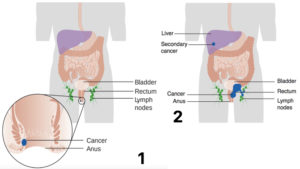 Overview
Overview
Anal cancer occurs in the anus. The anus is the end of the large intestine that opens to allow the passage of feces during a bowel movement. Other parts of the large bowel includes the colon the longest part of the large intestine and the rectum. The anus is about one and a half inch long.
The anus contains several types of tissues and each of these tissues contain several types of cells. The epithelium on the outside of the anus contains flat cells known as squamous cells.
Types of anal cancers
Squamous cell carcinomas – Squamous cell carcinomas are the most common type of anal cancer. They account for most anal cancers. These tumors come from squamous cells of the epithelium that lines the anal margin and most of the anal canal. In its earliest stage, squamous cell carcinoma is known as carcinoma in situ. The cancerous cells of CIS are limited to the epithelium and have not spread into any other tissues. Cells of invasive squamous cell carcinomas have already spread beyond the epithelium and are therefore no longer considered in situ.
Cloacogenic carcinomas – This is a subclass of the squamous cell cancers.
Approximately 30% of anal tumors develop in the transitional zone. Another word for this zone is the cloaca. Some tumors that form here are known as Cloacogenic carcinomas.
Adenocarcinoma – A small number of anal cancers are known as adenocarcinoma. (Adeno means gland) Adenocarcinomas can develop in glands located under the anal epithelium that release their secretions into the anal canal. They can also arise in apocrine glands (a type of sweat gland of the perianal skin).
Basal cell Carcinoma – Basal cell carcinomas are a type of skin cancer that can develop from the perianal skin. These tumors are rare in occurrence in anal cancers.
Malignant melanoma – Melanoma type of cancer is common on parts of the body that are exposed to the sun. however a small minority of skin cancers are of melanoma type developing from cells in the skin that produce brown pigment called melanin.
Risk factors –
Age – Most cases of the disease are diagnosed in people between the ages of 50 and 80.
Human Papiloma virus – The same virus responsible for cervical cancer is also responsible for Anal cancer.
Smoking – Use of tobacco and smoking increases the risk of developing anal cancer.
Fistulas – Long-term problems in the anal area, such as fistulas, can increase the chances of developing the disease.
Signs & Symptoms
Pain in the anal area.
Straining during bowel movement.
Anal itching.
Change in bowel habits such as more frequent or less frequent movements.
Change in the diameter of stool.
Abnormal discharge from the Anus.
Swollen lymph nodes in the anal or groin areas.
Diagnosis as per modern science
Endoscopy.
Anoscopy.
Fine needle aspiration biopsy.
CT Scan
MRI.
Staging
Stage 0 – Stage 0 is very early cancer that exists only in the top layer of anal epithelium.
Stage I – The cancer has spread beyond the top layer of anal tissue but it is less than 2 cms. in size.
Stage II – The cancer is larger than 2 cms. but it has not spread to nearby organs or lymph nodes.
Stage III – The cancer has grown into nearby organs such as the vagina or the bladder and has spread to lymph nodes around the rectum.
Stage IV – Cancer can be any size and may or may not have spread to lymph nodes but has spread to organs in other parts of the body.


